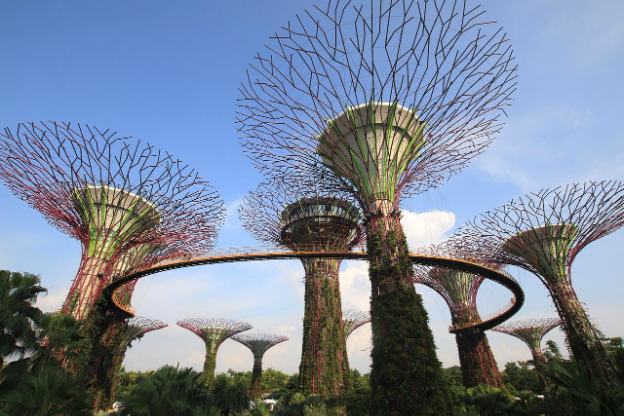Every day, we go about our lives benefiting from technological advances without considering where, how, and when they were developed.
Many people are surprised when they learn that something they took for granted originated in the tiny yet significant country of Singapore. However, it is one of the leading countries in medical technology, computing, and agriculture.

Image by Faizal Sugi from Pixabay
Medical Advances
Improving the lives of people with illnesses is possible thanks to several Singaporean companies; here are four medical technologies that were invented in this Southeast Asian country.
Mini-DNA Sequencing
DNA sequencing is used to detect illnesses like cancer. In the past, these machines were bulky and challenging to install in places with limited space. However, in 2016, the science engineering team at Singapore’s Illumina developed a mini-DNA sequencing machine that provided equal, if not better, results than previously larger models.
The tiny machine that can fit on a benchtop can generate between 7 to 25 million reads per run. It’s been instrumental in the early identification of breast cancer and mosquito-borne pathogens.
Improved Cardiovascular Stents
Coronary artery disease is caused when fatty plaque builds up inside the arteries and blocks them, restricting blood flow. Cardiovascular stents are installed inside a patient’s arteries to help widen them and allow better blood flow. The challenge has been that scar tissue forms inside the stent, causing the blood vessels to narrow again.
Singapore company Biosensors International Group patented an anti-restenotic drug for cardiovascular stents that slows down the growth of tissues inside the stent. A biodegradable polymer stent with a single drug-coated side, which enhances drug delivery, was also developed by the company — a world first.
Infrared Fever Screening
During the recent COVID-19 pandemic, infrared fever screening was one of the first tests required. This instant check allowed businesses to determine if a person could enter their premises without the risk of bringing the virus in with them.
This technology is, in fact, 20 years old. It was developed in Singapore via a three-way partnership between the Defense Science and Technology Agency, Singapore Technologies Electronics, and Chartered Electro-Optics. It was created at the beginning of the SARS outbreak in 2003.
Fertility Assistance
According to the World Health Organization (WHO), one in six people globally is affected by infertility. Two Singaporean Biodesign Innovation Fellows at Stanford University invented the Twoplus Sperm Guide. It’s a soft silicon device that the female wears during sex to give the sperm a better chance of fertilization.
Most sperm fall out of the vaginal canal into the lower region, which is highly acidic and kills them. The Twoplus Sperm Guide keeps them in the higher canal nearer the cervix, giving them more opportunity to meet the egg.
The product was commercialized in 2020 in Singapore, the UK, and the US.
Technology and Agriculture
It’s not just in the medical arena that Singaporean scientists and engineers have had great success. They also revolutionized a vital piece of computer usage, solved a space issue in their own backyard, and devised a solution to the rapidly decreasing seafood supply from the oceans.
Compact Data Storage
Anyone born before 2000 will remember floppy disks. Last century, computer users who wanted to copy data would insert a physical disk into a PC’s disk drive. They were then stored on shelves and in cabinets, occupying space and accumulating dust.
This all changed when Singaporean company Trek 2000 International revealed an invention called the ThumbDrive at the 2000 CeBIT International Technology Fair in Germany. This little device, which plugged into the USB port on a computer, revolutionized the portable media storage industry overnight.
The ThumbDrive paved the way for everything used today to store data, from micro SD cards to servers, including those that host casinos with slots from Hacksaw Gaming.
Vertical Farming Platform
Singapore is a tiny island; it’s only 268 sq mi. The biggest challenge for the country is the dense urbanization, resulting in little space for development. Food in Singapore is expensive, as most of it is imported.
Fortunately, Sky Urban Solutions tackled this problem by inventing a vertical farming platform called Sky Greens. These 30-foot-high aluminum towers have numerous planting troughs that provide ten times more yield per unit of land area than standard farming. The towers also have low maintenance, energy, and water needs.
Initially used to test the ability to grow leafy vegetables, the towers now produce spinach and Chinese cabbage for Singapore’s consumers at affordable prices since they do not have to be imported.
Sustainable Synthetic Seafood
The consumption of seafood may someday become unsustainable for the ocean supply. While innovations in synthetic meat like chicken and pork have already reached the market, seafood hasn’t been a consideration until recently.
Singaporean stem-cell biologists Dr. Sandhya Sriram and Dr. Ka Yi Ling have been working on synthetic seafood since 2019. The process involves extracting a sample of cells from shrimp, crab, or lobster, feeding them with liquid nutrients for four to six weeks, and then harvesting the meat.
Their company, Shiok Meats, released its first product, a Shiok shrimp dumpling. The challenge was that it came with a whopping US $5,000 per kilogram price tag. They’re working on innovating the cell feed to reduce the cost considerably.
Singapore’s Scientific Stars
Thanks to the hard work of scientists and engineers in Singapore, some solutions to real-world problems have been introduced globally.
Without them, fever screening during COVID-19 may have been more cumbersome. The early diagnosis of breast cancer for some people, thanks to mini-DNA sequencing, has saved lives. People with coronary heart disease have also benefited from these teams, and some infertile couples have received the happy news they had been wishing for.
Meanwhile, computer users worldwide may take for granted data storage that was revolutionized by Singapore engineers, as might locals who eat fresh vegetables at lower prices than before, thanks to vertical agriculture. Seafood supplies could become more sustainable in the future thanks to the creativity of Singaporean scientists.
Comments